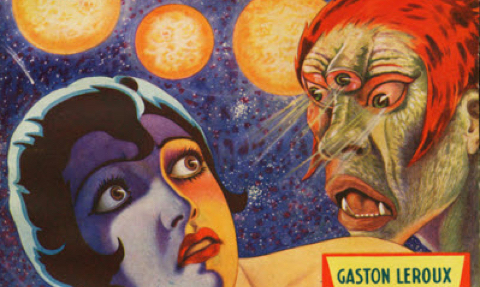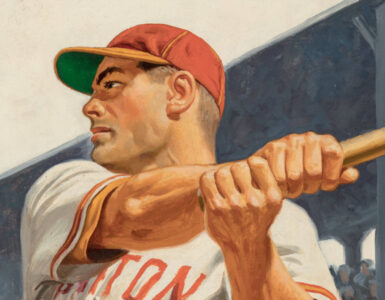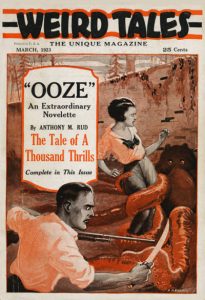 The stories and art of the pulp magazines have had a profound effect on popular culture across the globe. They have reverberated through a wide variety of media — comic books, movies, paperbacks and genre fiction, television, men’s adventure magazines, radio drama, and even video, anime, manga, and role-playing games.
The stories and art of the pulp magazines have had a profound effect on popular culture across the globe. They have reverberated through a wide variety of media — comic books, movies, paperbacks and genre fiction, television, men’s adventure magazines, radio drama, and even video, anime, manga, and role-playing games.
WEIRD TALES was the first periodical to specialize in the fantasy and horror genres. Premiering in early 1923, its publishers envisioned “The Unique Magazine” as a place for a writer to be given “free rein to express his innermost feelings in a manner befitting great literature.” In reality, the early issues of the pulp were filled with ghost stories, the decision of the magazine’s editor, Edwin Baird. Far more interested in his company’s REAL DETECTIVE AND MYSTERY STORIES, Baird had little interest in fantastic fiction.
Although never a big moneymaker, WEIRD TALES came into its own in late 1924 when Farnsworth Wright was named the magazine’s editor. In the years ahead, the pulp would become admired for its fantasy and supernatural fiction, publishing the work of Robert E. Howard, H. P. Lovecraft, Clark Ashton Smith, and later, Ray Bradbury. The magazine would also feature substantial efforts by Robert Bloch, August Derleth, Carl Jacobi, Henry Kuttner, Frank Belknap Long, C. L. Moore, Seabury Quinn, Manly Wade Wellman, Henry S. Whitehead, and others. It would likewise become noted for its artists. Hannes Bok, Margaret Brundage, Lee Brown Coye, and Virgil Finlay all contributed a great deal to the fantasy art field through their work for “The Unique Magazine.”
In addition to publishing some of the best fantasy and supernatural fiction of the twentieth century, WEIRD TALES, like the Munsey magazines, featured science fiction in its pages, offering tales of interplanetary expeditions, brain transference, death rays, lost races, parallel worlds, and more. Edmond Hamilton was its leading contributor of science fiction. With stories about alien invasions, space police, and evolution gone wild, the author became known as “world-wrecker” Hamilton. Other notable science fiction in the magazine included work by Austin Hall, Otis Adelbert Kline, C. L. Moore, Donald Wandrei, and Jack Williamson. H. P. Lovecraft also weaved his own style of science fiction into his tales of cosmic horror.
During the late summer of 1926, H. P. Lovecraft wrote “The Call of Cthulhu.” Initially rejected by WEIRD TALES editor Farnsworth Wright, it was first published in “The Unique Magazine” in its February 1928 issue. Although three minor, related stories predated it in what has come to be known as “The Cthulhu Mythos,” “The Call of Cthulhu” is one of the author’s seminal works. As writer and Lovecraft correspondent Fritz Leiber observed, “Here for the first time, Lovecraft moves horror from the realm of Earth to the stars.”
In the years remaining to Lovecraft following the publication of “The Call of Cthulhu,” he expanded on its themes in such tales as “The Whisperer in Darkness,” “At the Mountains of Madness,” and “The Shadow Out of Time,” depicting a universe of mind-numbing horror that was a reflection of his own materialistic atheism. Lovecraft also invited other writers to pen their own tales using the “synthetic folklore” he had created. “I think it is rather good fun to have this artificial mythology given an air of verisimilitude by wide citation.” Robert Bloch, August Derleth, Robert E. Howard, Henry Kuttner, Frank Belknap Long, and Clark Ashton Smith were some of the WEIRD TALES writers who authored their own “Mythos” fiction.
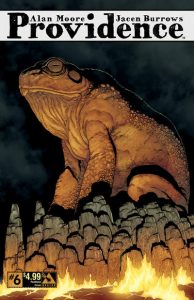 In later years — particularly following the death of “the old gentleman” — August Derleth worked to expand Lovecraft’s so-called “mythos,” albeit shaping it in a way that some scholars claim corrupted the original vision. Although he may have twisted H. P. Lovecraft’s ideas, Derleth also helped to popularize the author’s work. His Arkham House Publishers significantly expanded Lovecraft’s reputation, bringing the “Mythos” under the microscope of both academic and amateur scholars. Lovecraft’s stories became more widely read and popular, leading to adaptations in a variety of media including motion pictures, television, comic books, role-playing and video games, and even action figures and other toys. His stories are known the world over and though he lived much of his life in poverty, Lovecraft’s words and ideas have been transformed into a multi-million-dollar industry.
In later years — particularly following the death of “the old gentleman” — August Derleth worked to expand Lovecraft’s so-called “mythos,” albeit shaping it in a way that some scholars claim corrupted the original vision. Although he may have twisted H. P. Lovecraft’s ideas, Derleth also helped to popularize the author’s work. His Arkham House Publishers significantly expanded Lovecraft’s reputation, bringing the “Mythos” under the microscope of both academic and amateur scholars. Lovecraft’s stories became more widely read and popular, leading to adaptations in a variety of media including motion pictures, television, comic books, role-playing and video games, and even action figures and other toys. His stories are known the world over and though he lived much of his life in poverty, Lovecraft’s words and ideas have been transformed into a multi-million-dollar industry.
Although an important contributor to Lovecraft’s “Mythos,” Robert E. Howard’s greatest contribution to fantastic fiction was through his tales of Solomon Kane, Kull, and most importantly, Conan.
Howard became a regular contributor to “The Unique Magazine” in 1928, the same year that his first Solomon Kane story — “Red Shadows” — appeared. Kull of Atlantis would follow in 1929. Three years later, the first tale of Conan — “The Phoenix on the Sword” — would appear in the December 1932 WEIRD TALES.
“Conan seemed suddenly to grow up in my mind without much labor on my part and immediately a stream of stories flowed off my pen — or rather, off my typewriter — almost without effort on my part. I did not seem to be creating, but rather relating events that had occurred. Episode crowded on episode so fast that I could scarcely keep up with them. For weeks I did nothing but write of the adventures of Conan. The character took complete possession of my mind and crowded out everything else in the way of story-writing.”
In the stories about Solomon Kane, Kull, and Conan, Robert E. Howard created a genre. As Fritz Leiber wrote in the July 1961 issue of AMRA:
“I feel more certain than ever that this field should be called the sword-and-sorcery story. This accurately describes the points of culture-level and supernatural element and also immediately distinguishes it from the cloak-and-sword (historical adventure) story — and (quite incidentally) from the cloak-and-dagger (international espionage) story too!”
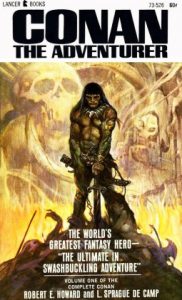 More than ninety years after the first publication of “Red Shadows,” Robert E. Howard’s sword-and-sorcery stories continue to resonate through popular culture. They have inspired motion pictures, comic books, television and animated series, action figures, role-playing and video games, and even heavy metal music and a live-action show at Universal Studios Hollywood. Most importantly, his fiction has inspired other writers to spin their own sword-and-sorcery stories. Lin Carter, Glen Cook, John Jakes, Henry Kuttner, Fritz Leiber, Michael Moorcock, C. L. Moore, Charles Saunders, Karl Edward Wagner, and others have all contributed to the genre that Howard popularized.
More than ninety years after the first publication of “Red Shadows,” Robert E. Howard’s sword-and-sorcery stories continue to resonate through popular culture. They have inspired motion pictures, comic books, television and animated series, action figures, role-playing and video games, and even heavy metal music and a live-action show at Universal Studios Hollywood. Most importantly, his fiction has inspired other writers to spin their own sword-and-sorcery stories. Lin Carter, Glen Cook, John Jakes, Henry Kuttner, Fritz Leiber, Michael Moorcock, C. L. Moore, Charles Saunders, Karl Edward Wagner, and others have all contributed to the genre that Howard popularized.
Not long after Robert E. Howard’s death in 1936, his friend and correspondent H. P. Lovecraft wrote: “It is hard to describe precisely what made Mr. Howard’s stories stand out so sharply; but the real secret is that he himself is in every one of them.”
Along with Lovecraft’s “The Call of Cthulhu” and Howard’s “Red Shadows,” Clark Ashton Smith’s first story for “The Unique Magazine” also appeared in 1928. Smith was the third member of the WEIRD TALES triumvirate. However, he has not achieved the acclaim of Howard and Lovecraft.
Largely self-taught, Clark Ashton Smith spent the majority of his life in Auburn, California, dwelling in a small cabin erected by his parents. He began to write in his youth and gained some notoriety as a poet. His blank verse poem, “The Hashish Eater,” brought Smith to the attention of H. P. Lovecraft. The pair began exchanging letters. Later, Smith also began corresponding with Robert E. Howard.
The advent of The Great Depression and the declining health of both his parents led Smith to fiction writing. Beginning in 1930 and running through 1936, he published nearly ninety stories, mainly in WEIRD TALES, WONDER STORIES, and STRANGE TALES OF MYSTERY AND TERROR.
Although his work has rarely appeared outside the printed page — a few stories were adapted for television, movies, the graphic format, and role-playing games — the fiction of Clark Ashton Smith inspired other writers.
In a letter to Donald Sidney-Fryer, Harlan Ellison wrote:
“It is often impossible to say where a man’s inspirations come from, but in the lineal descent of my own writings, I have no hesitation in saying had it not been for Clark Ashton Smith and the wonders he revealed to me, at that precise moment of my youth in which I was most malleable, most desperate for direction, I might well have gone in any one of the thousand other directions taken by my contemporaries, and wound up infinitely poorer in spirit, intellect, prestige and satisfaction than I am today. As I owe a great debt to science fiction as a whole, to fandom as a particular, and to the other writers who encouraged me in my work . . . I owe the greatest of debts to Clark Ashton Smith, for he truly opened up the universe for me.”
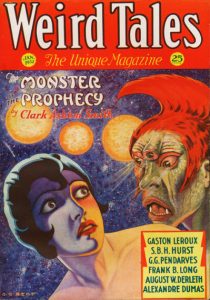 Other writers who owe a debt to Smith include Fritz Leiber, George R. R. Martin, Michael Moorcock, Jack Vance, Gene Wolfe, and most notably, Ray Bradbury:
Other writers who owe a debt to Smith include Fritz Leiber, George R. R. Martin, Michael Moorcock, Jack Vance, Gene Wolfe, and most notably, Ray Bradbury:
“Looking back on the years when I was eleven and twelve, I remember two stories. The first was “The City of the Singing Flame,” the second was “Master of the Asteroid.” Both were by Clark Ashton Smith. These stories more than any others I can remember had everything to do with my decision, while in the seventh grade, to become a writer. In the hardbound book field there were a few writers, of course, who set me going, but in the short-story form CAS stood alone on my horizon. He filled my mind with incredible worlds, impossibly beautiful cities, and still more fantastic creatures on those worlds and in those cities. . . . Take one step across the threshold of his stories, and you plunge into color, sound, taste, smell, and texture — into language.”
“The Unique Magazine” has been inspiring all sorts of creators for ninety-six years. However, WEIRD TALES is just one of the many rough-paper magazines that have inspired pop culture creators over the decades. PulpFest 2019 will focus on the many ways pulp fiction and pulp art have inspired and continue to inspire creators. We’re calling this year’s theme “Children of the Pulps and Other Stories,” an examination of the pervasive influence of pulp magazines on contemporary pop culture. We hope you’ll join us from August 15 – 18 at the beautiful DoubleTree by Hilton Hotel Pittsburgh – Cranberry in Mars, Pennsylvania.
(The first issue of WEIRD TALES — dated March 1923 — featured cover art by R. R. Epperly. It is best remembered for publishing Anthony M. Rud’s “Ooze,” a story concerning a giant amoeba. Also featured in the issue were tales by pulpsters Otis Adelbert Kline, Joel Townsley Rogers, R. T. M. Scott, and Harold Ward. The issue was put together by Edwin Baird, the editor of the magazine until the November 1924 issue, when Wright took the helm.
Writer Alan Moore’s and artist Jacen Burrows’s PROVIDENCE is a twelve-issue comic book series published by Avatar Press. According to the League of Comic Geeks, PROVIDENCE “deconstructs all of Lovecraft’s concepts, reinventing the entirety of his work inside a painstakingly researched framework of American history.” The series ran from 2015 through 2017.
Although Robert E. Howard’s work — particularly his Conan stories — had been collected in small press editions over the years, the Lancer and Ace paperback editions of 1966 – 1977 delivered the character to the masses. Lancer’s CONAN THE ADVENTURER — released in 1966 — was the first of the volumes. Undoubtedly, it was Frank Frazetta’s stunning cover artwork that initially sold the character to readers. However, it was Howard’s expressive writing that kept them clamoring for more.
C. C. Senf‘s cover for the January 1932 issue of WEIRD TALES is one of three illustrating a Clark Ashton Smith story. The others include the April 1938 issue, illustrating “The Garden of Adompha,” and the September 1947 number, illustrating “Quest of the Gazolba,” an abridged version of “The Voyage of King Euvoran.” The latter stories are beyond Smith’s period of active fiction-writing. By 1936, he had turned away from writing prose, concentrating instead on poetry, art, and sculpture.
To learn more about the influence of WEIRD TALES, please visit the PulpFest Instagram page.)

